Quasars represent some of the most luminous and energetic phenomena in the universe. These distant powerhouses are driven by supermassive black holes—colossal gravitational engines with masses millions to billions of times that of our sun—which actively devour surrounding matter at incredible rates.
As gas, dust, and stellar material spiral inward through an accretion disk superheated to millions of degrees, this matter releases tremendous energy across the electromagnetic spectrum before crossing the event horizon. The resulting emissions can outshine entire galaxies despite originating from a region no larger than our solar system.
The discovery of billion-solar-mass black holes in distant quasars challenges conventional growth models in astrophysics. Scientists have observed these supermassive black holes (SMBHs) at redshifts beyond z≳6, when the universe was less than a billion years old—theoretically insufficient time for them to reach such enormous masses through standard Eddington-limited accretion from stellar-mass seeds.
